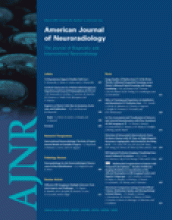Abstract
BACKGROUND AND PURPOSE: Routine CT of the brain is traditionally performed with sequential CT. We assessed whether sequential CT can be replaced with thinly collimated multisection spiral CT without loss of image quality.
Materials and METHODS: An observer study was conducted using data from 23 patients who were scanned with both a sequential (collimation, 4 × 5 mm) and a spiral technique (collimation, 4 × 1 mm; pitch, 0.875). Each sequential image was registered with 4 combined spiral CT images at 1.2 mm distance. Two neuroradiologists blindly scored 232 image pairs on 6 aspects: streak artifacts, visualization of brain tissue near skull, visualization of hypoattenuated lesions, gray/white matter differentiation, image noise, and overall image quality. A 5-point scale (range, −2 to 2) was used to score the preferences. The 23 pairs of complete scans were scored likewise. In this case, no registration was performed.
RESULTS: Virtually all mean scores were positive (ie, showed a preference for the spiral technique). For the comparison of image pairs, the preferences with respect to streak artifacts (mean score, 1.36), visualization of brain tissue near the skull (mean score, 0.69), and overall image quality (mean score, 0.95) were significant (P < .001). With respect to visualization of hypo-attenuated lesions, image noise, and gray/white matter differentiation (mean scores, 0.18, 0.27, and 0.13), the preferences for spiral CT were not significant. The preferences for the spiral technique were also present at the comparison of the complete scans.
CONCLUSION: Thinly collimated multisection spiral CT of the brain with image combining is superior to thickly collimated sequential CT.
- Copyright © American Society of Neuroradiology












